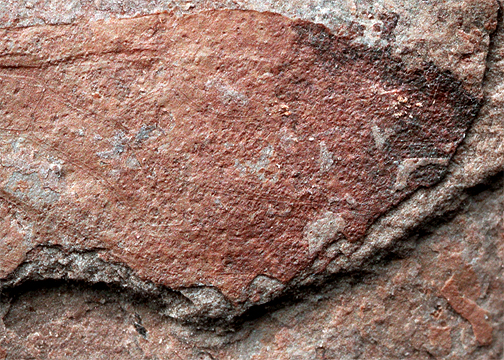Abstract
Using Reflectance Transformation Imaging, we re-examined the holotype of Moltenia rieki Schlüter, 2000, one of the few Triassic Hymenoptera known from Gondwana. The new data revealed characters of venation which were overlooked and/or misapprehended in the original description, and which have putative systematic relevance. Notably, the branching point of Rs, previously assumed to be located in a distal position, is actually located basal to the 2r-rs cross-vein, a trait suggesting a placement within the subfamily Archexyelinae. In combination with other traits, such as a very short 1-Rs and a fully sclerotized pterostigma, Moltenia rieki stands out as a distinctive member of this taxon. This study broadens our knowledge of early Hymenoptera evolution and suggests a wide Triassic distribution for Archexyelinae.
References
- Anderson, J.M., Anderson, H.M. & Cruickshank, R.D. (1998) Late Triassic ecosystems of the Molteno/Lower Elliot Biome of Southern Africa. Palaeontology, 41, 387–421.
- Béthoux, O. & Anderson, J.M. (2021) The Polycytellidae viewed as Gondwanan Glosselytrodea. Palaeoentomology, 4 (6), 550–558. https://doi.org/10.11646/palaeoentomology.4.6.5
- Béthoux, O., Llamosi, A. & Toussaint, S. (2016) Reinvestigation of Protelytron permianum (Insecta; Early Permian; USA) as an example for applying reflectance transformation imaging to insect imprint fossils. Fossil Record, 20, 1–7. https://doi.org/10.5194/fr-20-1-2016
- Denisova, E.A., Kopylov, D.S. & Rasnitsyn, A.P. (2024) New Archexyelinae (Hymenoptera: Xyelidae) from the Triassic Madygen Formation of Kyrgyzstan. PalZ, 98, 95–104. https://doi.org/10.1007/s12542-023-00666-6
- Engel, M.S. (2005) A new sawfly from the Triassic of Queensland (Hymenoptera: Xyelidae). Memoirs of the Queensland Museum, 51, 558.
- Gerstaecker, C.E.A. (1867) Symphyta. In: Handbuch der Zoologie. Wilhelm Engelmann 1, Leipzig, pp. 108–130.
- Grimaldi, D. & Engel, M.S. (2005) Evolution of the insects. Cambridge University Press, New York, xv+755 pp.
- Kopylov, D.S. (2014) New sawflies of the subfamily Madygellinae (Hymenoptera, Xyelidae) from the Middle-Upper Triassic of Kyrgyzstan. Paleontological Journal, 48, 610–620. https://doi.org/10.1134/S0031030114060070
- Lara, M.B., Rasnitsyn, A.P. & Zavattieri, A.M. (2014) Potrerilloxyela menendezi gen. et sp. nov. from the Late Triassic of Argentina: The oldest representative of Xyelidae (Hymenoptera: Symphyta) for Americas. Paleontological Journal, 48, 182–190. https://doi.org/10.1134/S0031030114020075
- Linnaeus, C. (1758) Systema naturae per regna tria naturae, secundum classes, ordines, genera, species, cum characteribus, differentiis, synonymis, locis. Editio decima, reformata. Tomus I. Holmiae, Laurentii Salvii, pp. 553–583. https://doi.org/10.5962/bhl.title.542
- Newman, E. (1834) Attempted division of British insects into natural orders. Entomological Magazine, 11, 379–430.
- Montagna, M., Magoga, G., Stockar, R. & Magnani, F. (2024) The contribution of the Middle Triassic fossil assemblage of Monte San Giorgio to insect evolution. Communications Biology, 7, 1023. https://doi.org/10.1038/s42003-024-06678-5
- Oyama, N. & Maeda, H. (2020) Madygella humioi sp. nov. from the Upper Triassic Mine Group, Southwest Japan: The oldest record of a sawfly (Hymenoptera: Symphyta) in East Asia. Paleontological Research, 24, 64–71. https://doi.org/10.2517/2019PR005
- Oyama, N., Wappler, T., Anderson, J.M. & Béthoux, O. (2025) Data from: Redescription and systematic affinities of Moltenia rieki Schlüter, 2000 (Xyelidae: Archexyelinae) (Molteno Formation, South Africa), one of the rare Gondwanan Triassic Hymenoptera. data.InDoRES. https://doi.org/10.48579/PRO/BYSMBY
- Rasnitsyn, A.P. (1964) New Triassic Hymenoptera of Central Asia. Paleontologicheskii Zhurnal, 1, 88–96.
- Rasnitsyn, A.P. (1969) Origin and evolution of lower Hymenoptera. Trudy Paleontologicheskogo Instituta Akademii Nauk SSSR, 123, 1–196.
- Riek, E.F. (1955) Fossil insects from the Triassic beds at Mt. Crosby, Queensland. Australian Journal of Zoology, 3, 654–691. https://doi.org/10.1071/ZO9550654
- Schlüter, T. (2000) Moltenia rieki n. gen., n. sp. (Hymenoptera Xyelidae), a tentative sawfly from the Molteno Formation (Upper Triassic), South Africa. Paläontologische Zeitschrift, 74, 75–78. https://doi.org/10.1007/BF02987953
- Shcherbakov, D.E. (2008) Madygen, Triassic Lagerstätte number one, before and after Sharov. Alavesia, 2, 113–124.
- Taeger, A., Blank, S.M. & Liston, A.D. (2010) World catalog of Symphyta (Hymenoptera). Zootaxa, 2580 (1), 1–1064. https://doi.org/10.11646/zootaxa.2580.1.1
- Voigt, S., Buchwitz, M., Fischer, J., Kogan, I., Moisan, P., Schneider, J., Spindler, F., Brosig, A., Preusse, M., Scholze, F. & Linnemann, U. (2017) Triassic life in an inland lake basin of the warm-temperate biome—the Madygen Lagerstätte (southwest Kyrgyzstan, Central Asia). In: Fraser N.C. & Sues H.D. (Eds), Terrestrial conservation Lagerstätten: windows into the evolution of life on land. Dunedin, Edinburgh, UK, pp. 65–104. https://doi.org/10.2307/jj.12638994


